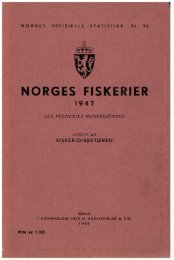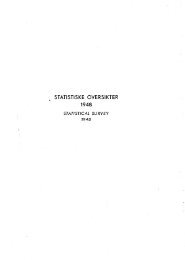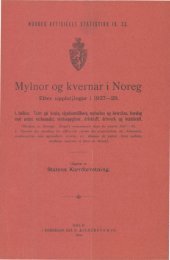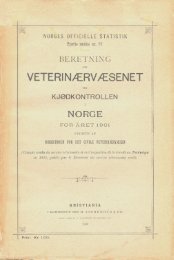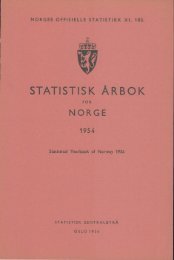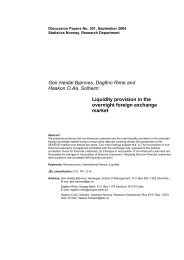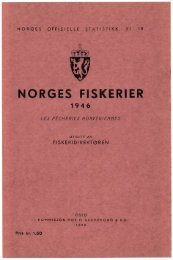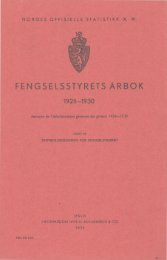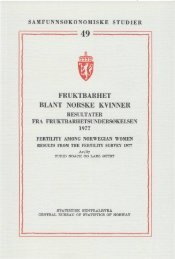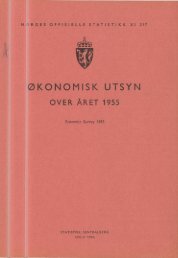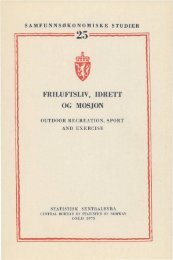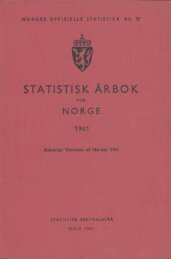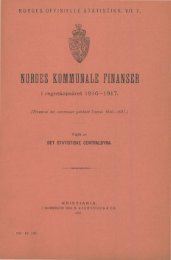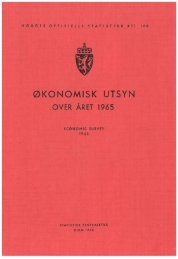Empirical life cycle models of labour supply and - Statistisk sentralbyrå
Empirical life cycle models of labour supply and - Statistisk sentralbyrå
Empirical life cycle models of labour supply and - Statistisk sentralbyrå
Create successful ePaper yourself
Turn your PDF publications into a flip-book with our unique Google optimized e-Paper software.
Social <strong>and</strong> Economic Studies 9.1 <strong>Empirical</strong> Life Cycle Models<br />
as a pr<strong>of</strong>it maximization problem, the requirement that the Frisch dem<strong>and</strong>s are<br />
linear in pu 1/A implies that dem<strong>and</strong> is linearly related to within-period full<br />
income. Full income at age t, Yt , is defined as the sum <strong>of</strong> the value <strong>of</strong> the<br />
household's initial time endowment 1E, <strong>and</strong> its interest incomes <strong>and</strong> asset<br />
decumulation,<br />
(39) Yt = wtr; rtAt-i - (At - At-i)•<br />
The pr<strong>of</strong>it function approach, however, allows for non-separable within period<br />
preferences.<br />
Blundell, Fry <strong>and</strong> Meghir (1985) show an analogous result within the same<br />
framework, that is, relaxing intraperiod additive separability leads to unitary<br />
within-period full income elasticities if the loglinear Frisch dem<strong>and</strong>s are to be<br />
loglinear in Ao. The use <strong>of</strong> Frisch dem<strong>and</strong> functions that are derived either from<br />
a specification <strong>of</strong> direct utility or from the pr<strong>of</strong>it function, then introduces quite<br />
strong restrictions on intratemporal preferences.<br />
Intuitively we would consider that the use <strong>of</strong> highly aggregated Hicks composite<br />
goods reduces the restrictiveness <strong>of</strong> assuming intraperiod additive separability.<br />
Intraperiod additive separability can then turn out to be a reasonable<br />
approximation for <strong>life</strong> <strong>cycle</strong> <strong>models</strong> <strong>of</strong> highly aggregated Hicks composite goods.<br />
The assumption <strong>of</strong> intertemporal additive separability can also be questioned.<br />
According to Blundell (1987), the indirect within-period utility at age t<br />
corresponding to the pr<strong>of</strong>it function <strong>of</strong> Browning et al., is <strong>of</strong> the Gorman Polar<br />
form<br />
(40) G =I bt(124)<br />
where It is some concave monotonic transformation that determines the<br />
intertemporal allocation <strong>of</strong> the goods, <strong>and</strong> at (pt) <strong>and</strong> bt (pt) are particular<br />
concave linear homogeneous functions <strong>of</strong> the vector pt <strong>of</strong> prices discounted to<br />
period zero.<br />
Blundell uses this specification to discuss the restrictions on intertemporal<br />
substitution implied by the pr<strong>of</strong>it function <strong>of</strong> Browning, Deaton <strong>and</strong> Irish. He<br />
follows Browning (1985) <strong>and</strong> assumes that the intertemporal substitution<br />
possibilities best can be measured by the intertemporal elasticity <strong>of</strong><br />
substitution, = GyIYGyy , where Gy OGIOY <strong>and</strong> Gyy °GSM'. The<br />
utility index (40 implies<br />
(41) (1)t<br />
l yt at (Et )<br />
4{ [Yt at(pdlibt(Pt )IMEt )<br />
— at(pt )]lbt(p)lYt<br />
where denotes partial derivative. Since Yt at (pt) is dominated by Yt , this<br />
means that bt (pt) represents the substitution possibilities for rich people. This<br />
39



